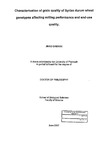Characterisation of grain quality of Syrian durum wheat genotypes affecting milling performance and end-use quality
| dc.contributor.author | Samaan, Jihad | |
| dc.contributor.other | Faculty of Science and Engineering | en_US |
| dc.date.accessioned | 2013-10-29T12:55:40Z | |
| dc.date.available | 2013-10-29T12:55:40Z | |
| dc.date.issued | 2007 | |
| dc.identifier | NOT AVAILABLE | en_US |
| dc.identifier.uri | http://hdl.handle.net/10026.1/2450 | |
| dc.description | Merged with duplicate record 10026.1/707 on 03.04.2017 by CS (TIS) | |
| dc.description | Access to the full version of this thesis is unavailable due to third party copyright restrictions | |
| dc.description.abstract |
Durum wheat is a strategic crop in Syria produced in high quantities and used mainly for the production of Arabic bread, bulgur and pasta. This investigation is the first known systematic study relating the grain quality of nine domestic cultivars to milling performance and pasta quality in order to map the Syrian durum wheat characteristics onto the world market requirements and hence determine the potential export development. Furthermore, it examines the influence of environment, genotype and their interaction on the physiochemical characteristics of five durum wheat cultivars grown in five different locations under rainfed and irrigated conditions in Syria. AACC standard methods were principally used in this investigation. Despite the soundness of grains revealed by elevated test weight (83.1-85.9 kghlˉ¹), 1000 kernel weight (42.50-55.0 g) and falling number (433-597 sec), it is necessary to improve the kernel quality of Syrian durum wheat for the degree of vitreousness and total protein content (average quality data were 65% and 12.6% respectively) for better end-use product quality. In addition, irrigation demonstrated a significant effect on kernel quality traits, for example, irrigated samples showed the highest test weights. The importance of three physiochemical markers, namely total protein content, the degree of vitreousness and kernel hardness was substantiated and presented useful indicators for future development in Syrian durum wheat breeding programmes. Optimum cooking time of pasta and cooked pasta firmness correlated significantly with final viscosity (r = 0.51, 0.73), dough development time (r = 0.69 and 0.63) and Rmax (r = -0.64, -0.43) which indicated that RV A, farinograph and extensograph techniques were useful indicators of the cooking properties of pasta. Overall, this study revealed that to achieve the aim of improving the domestic production and expanding the potential export of durum wheat crop in Syria, both genetic and agronomic improvements are still required. | en_US |
| dc.language.iso | en | en_US |
| dc.publisher | University of Plymouth | en_US |
| dc.title | Characterisation of grain quality of Syrian durum wheat genotypes affecting milling performance and end-use quality | en_US |
| dc.type | Thesis | |
| plymouth.version | Full version | en_US |
| dc.identifier.doi | http://dx.doi.org/10.24382/4299 |
Files in this item
This item appears in the following Collection(s)
-
01 Research Theses Main Collection
Research Theses Main



